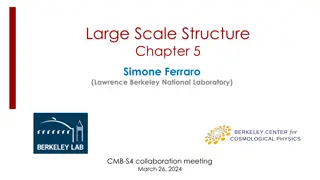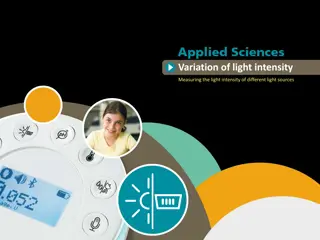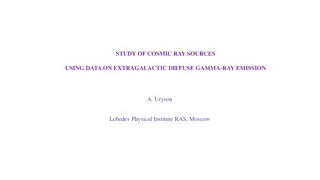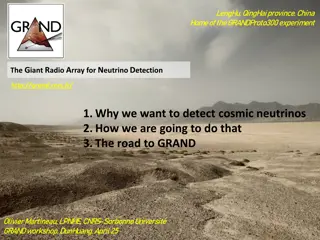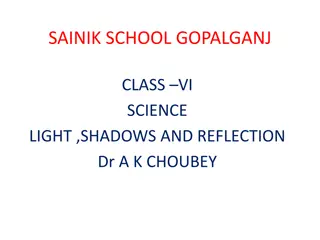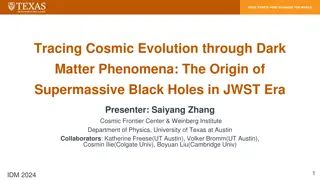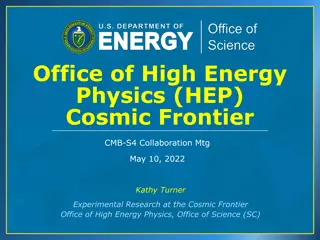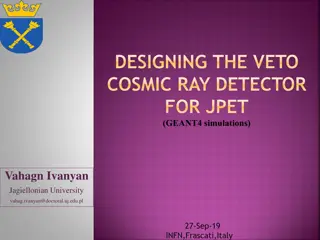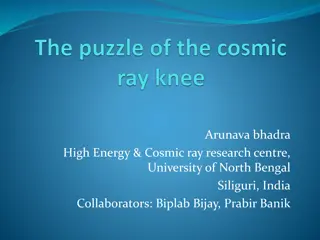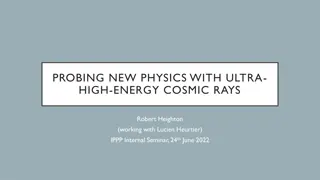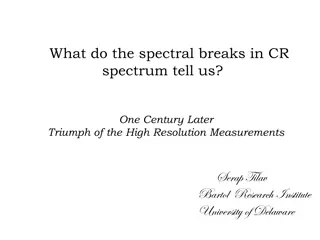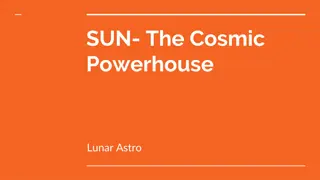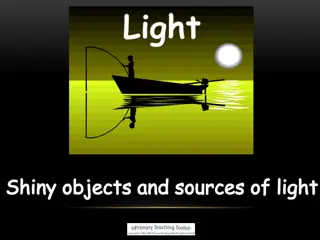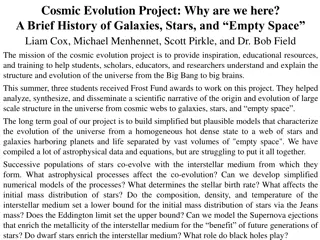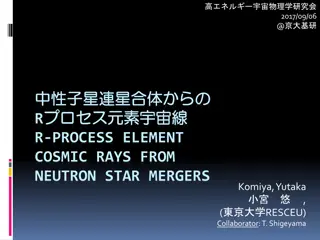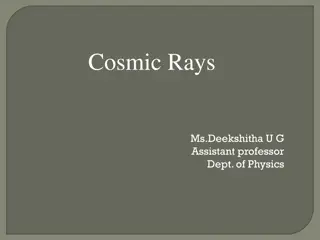COSMIC Light vs COSMIC Classic Manual: COSMIC Light vs COSMIC Classic Manual:
This study explores the impact of using either COSMIC Light or COSMIC Classic Manual on measurement results to propose potential improvements for both methods. Examining functional size measurement and software development velocity, it aims to uncover differences and causal factors in measurement outcomes.
Download Presentation

Please find below an Image/Link to download the presentation.
The content on the website is provided AS IS for your information and personal use only. It may not be sold, licensed, or shared on other websites without obtaining consent from the author.If you encounter any issues during the download, it is possible that the publisher has removed the file from their server.
You are allowed to download the files provided on this website for personal or commercial use, subject to the condition that they are used lawfully. All files are the property of their respective owners.
The content on the website is provided AS IS for your information and personal use only. It may not be sold, licensed, or shared on other websites without obtaining consent from the author.
E N D
Presentation Transcript
COSMIC Light vs COSMIC Classic Manual: COSMIC Light vs COSMIC Classic Manual: Case Studies in Functional Size Case Studies in Functional Size Measurement Measurement Tuna Hacaloglu, Tuna Hacaloglu, Huseyin HuseyinUnlu, Onur Demirors, Unlu, Onur Demirors, Alain AlainAbran Abran October October 29 Mexico MexicoCity 29- -30, 2020 30, 2020 City
Agenda Introduction Research Methodology - Case Study Design - Description of the Cases - Measurement of Cases Results and Discussion Conclusion and Future Works
Functional Size Measurement Objective size measurement have many benefits: establishes estimation models contributes to internal process improvement and benchmarking helps to control the project s scope change
COSMIC FSM One of the most commonly used FSM method ISO compliant based on counting the data movements Entry, Exit, Read and Write has various guidelines and case studies For business application software Real-time software Service-oriented software all of which are based on the COSMIC Measurement Manual version 4.0.2 which have 115 pages may be perceived as overwhelming for developers who are at the learning stage or who have limited time available
Alternative Software Development Velocity with COSMIC Function Points Light version of COSMIC Function Points Summarizing the COSMIC Measurement Manual in only 13 pages To facilitate the learning process
Aim of the study To explore how using either the COSMIC Measurement Manual (COSMIC Classic) or Software Development Velocity with COSMIC Function Points (COSMIC Light) Affects the measurement results, in order to suggest possible improvement for both
Case Study Design RQ RQ1 1. . Is there a difference between CFP values when measuring using COSMIC Classic versus COSMIC Light? RQ RQ2 2. What are the causes of the difference in measurement results? RQ RQ3 3. . How does the effort spent on measurement differ when using COSMIC Classic versus COSMIC Light?
Case Selection Criteria Criterion 1: projects that measurers were not familiar with, in order to ensure the objectivity in the measurement process. Criterion 2: measurers ability to understand the project domain. Criterion 3: availability of functional requirements documentation at an understandable level of detail for both measurers.
Data Collection Procedure CFP values obtained as a result of COSMIC Functional Size Measurement Time spent for measuring the functional size Assumptions and comments
Descriptionof theMeasurers Measurement is planned with 2 independent measurers Measurer 1 has three years of experience with the COSMIC FSM method, and Measurer 2 has one year of experience with COSMIC FSM method. The measurers have not taken the certification exam; have taken a formal COSMIC course and together they have measured more than 20 projects with over 5,000 function points.
Description of the Cases Case 1 is a business application software, Case 1 is a business application software, written in a detailed way similar to a complete SRS format, includes 13 use cases. the documentation included use case descriptions, user interfaces, and an entity- relationship diagram (ERD) in the SRS document. Case 2 is also a business application, Case 2 is also a business application, includes single sprint, no use case descriptions or data models such as an entity-relationship diagram in this sprint documentation. the functional user requirements (FURs) were written in simple textual descriptions together with screen mock-ups.
Measurement Results Measurement Effort Measurement Effort (minutes) (minutes) Measured Size Measured Size (CFP) (CFP) Case Case COSMIC Classic (Measurer 1) COSMIC Light (Measurer 2) COSMIC Classic (Measurer 2) COSMIC Light (Measurer 1) Case 1 88 93 71 85 Case 2 35 48 77 116
Measurement Results COSMIC Classic is much more detailed than COSMIC Light, but the measurers who used COSMIC Classic as the reference completed the measurement in less time in both cases. In both cases the measurers who used COSMIC Light found higher CFP values. Measurers using COSMIC Light can: perform the measurement; identify more functional size-related items, but it takes more time for this specific study. One of the reasons for the change in CFP values observed in the measurement results of Case 2 is related to the EXIT data movement. For EXITs, both manuals specify the following rule: An Exit accounts for all data manipulation to create the data group attributes to be output and/or to enable the data group to be output (e.g. formatting and presentation manipulations) and to be routed to the intended functional user. However, in Case 2, Measurer 1, using COSMIC Classic, identified more EXIT data movements than Measurer 2, who used COSMIC Light. The reason is, in Case 2 there were requirements specifying that the reports displayed on the screen could be exported in Microsoft Excel format. The measurer who used COSMIC Classic considered this extra type of display as another functional process and counted it as an EXIT data movement. The authors suggest that this issue needs to be clarified in both manuals. Measurer 2, on the other hand, did not define these as new EXITs.
Measurement Results Object of Interest (OOI) concept and data groups Functional Process independence, and Error/Confirmation messages.
Object of Interest (OOI) concept and data groups Object Object of of Interest COSMIC Light. Identification Identification of of persistent COSMIC Classic but are not mentioned in COSMIC Light. When measuring Case 2, Measurer 1 paid special attention to the OOI concept and found more data movements while Measurer 2, who performed the measurement using COSMIC Light, did not consider this concept. In Case 2, one of the functional user requirements refers to a search Measurer 2, using COSMIC Light, added added an an extra extra CFP attribute of the same OOI. This led to greater CFP values for the Case 2 measurement based on COSMIC Light. In Case 1, data data analysis analysis in in the the form form of of ERD ERD in the requirements document helped Measurer 1 to identify the data groups without considering OOI. Interest (OOI) (OOI) concept is described in detail in COSMIC Classic, not mentioned in persistent and and transient transient data data groups groups used to define OOI are described in search by filtering feature by a a filtering filtering feature feature, although it is an feature: : CFP for for each each filtering
Variation in CFP Values Related to Functional Process Independence COSMIC Classic gives a detailed definition of the Functional offers only a short description. In COSMIC Classic, under the functional process identification section, Independence functional functional processes processes is explained in detail whereas this detail is not mentioned in COSMIC Light. COSMIC Classic states that in the COSMIC method (as in all other FSM Methods) each functional process is defined, modeled and measured independently of, i.e. without reference to, any other functional process in the same software being measured . COSMIC Classic further specifies that when a statement of a FUR is implemented in software, any "functional commonality" may or may not be developed as reusable software. All implementation decisions including the extent of actual or potential software reuse must be ignored when measuring functional size. Functional Process Process while COSMIC Light Independence of of
Variation in CFP Values Related to Functional Process Independence COSMIC Classic specifies that when a statement of a FUR is implemented in software, any "functional commonality" may or may not be developed as reusable software. All implementation decisions including the extent of actual or potential software reuse must be ignored when measuring functional size The following observations apply to Case 2, where functional observed: Complying with the guidance information given in COSMIC Classic , Measurer 1 included the functional similarities in his CFP calculation. Since this detail is not mentioned in COSMIC Light, Measurer 2 eliminated the functional similarities in the functional size measurement. functional similarities similarities had been
Variations in CFP Values Related to Error/ Confirmation Messages COSMIC Classic includes detailed guidance on error/ COSMIC Light has only briefly presented under the description description. COSMIC Classic states that If the FUR of the functional process does not require any type of error/confirmation message to be issued, do not identify any corresponding Exit . error/ confirmation confirmation messages messages, the EXIT EXIT type type data data movement movement- -related related
Variations in CFP Values Related to Error/ Confirmation Messages In Case 2, did not have a FUR specifying the information related to system behavior regarding error or confirmation messages: Measurer 1, by referring to COSMIC Classic , did not identify or count any related data movement. Measurer 2 made an assumption and included the error/ confirmation messages in the measurement process. Lack of detail regarding error/ confirmation messages in COSMIC Light causes inconsistencies in the measurement. For better measurement consistency, this information could also be added to COSMIC Light. On the other hand, in Case 1, the system behavior regarding error or confirmation messages was specified in use case descriptions. Thus, there were no major inconsistencies in Case 1 regarding error or confirmation messages.
Other Comments Regarding Measurement During the case studies, some problems already stated in the literature were also observed: - importance of the quality of requirements documents, importance of the quality of requirements documents, - - difficulty identifying OOIs due to the lack of data modeling or errors in the data model (in Case 1), and difficulty identifying OOIs due to the lack of data modeling or errors in the data model (in Case 1), and - - challenges due to individual assumptions and understandings challenges due to individual assumptions and understandings one of the measurers defined different EXITs for each of the confirmations and errors throughout the measurement whereas the other one counted them as pairs. - The lack of data models and the paucity of information regarding requirements caused a challenge for The lack of data models and the paucity of information regarding requirements caused a challenge for Case 2: Case 2: there was a combo box, but whether it retrieved its content from persistent storage or not was not specified in the requirements document. For this reason, the number of OOIs and the type of data movement involved were not clear. In addition, even though the Guideline for Sizing Business Application Software specifies details related to combo boxes, neither Manual 1 or Manual 2 includes such detail.
Conclusion COSMIC Light is the light version of COSMIC Classic, it is still capable of yielding good measurement results: when using COSMIC Light as the reference, the measurers identified more data movements Analysis of the detailed measurement results obtained while using these two different manuals identified that the measurement differences came from three measurable concepts Object of Interest (OOI) concept and corresponding data groups, Functional process independence, and Error/Confirmation messages in particular when the quality and completeness of the project documentation varied. The authors suggest the incorporation of details related to these concepts into COSMIC Light. When the effort spent on measurement while using COSMIC Classic and COSMIC Light was compared, no significant difference was noticeable. However, in both case studies, it took slightly more time to complete the measurement using COSMIC Light.
Future Works COSMIC Light, the light version of the COSMIC FSM method, is intended to facilitate and speed up the learning process for newcomers to the COSMIC method. Future work is needed to assess the usability and learnability of both manuals; for example, another experiment could be conducted with newcomers to the COSMIC FSM methods trained using either COSMIC Classic or COSMIC Light. In this way, both the learning time and the measurement results could be compared. In addition, effort estimation models could be developed and the effectiveness of each manual could be compared on the basis of the results they provide in terms of effort estimation. Future studies on questions such as Would it be useful/essential to go through the 115 pages of COSMIC Classic when the recommended minor additions to COSMIC Light would also be valuable.
References Salmano lu, M., zt rk, K., Ba r yan k, S., Ungan, E., Demir rs, O.: Benefits and challenges of measuring software size: early results in a large organization. Presented at the 25th International Workshop on Software Measurement and 10th International Conference on Software Process and Product Measurement, IWSM-Mensura (2015). Abran, A.: Software project estimation: the fundamentals for providing high quality information to decision makers. John Wiley & Sons (2015). Albrecht, A.J.: Measuring application development productivity. Presented at the Proc. Joint Share, Guide, and IBM Application Development Symposium, 1979 (1979). Abran, A., Desharnais, J.-M., Zarour, M., Demir rs, O.: Productivity-based software estimation models and process improvement: an empirical study. Int J Adv Softw. 8, 103 114 (2015). Commeyne, C., Abran, A., Djouab, R.: Effort estimation with story points and cosmic function points-an industry case study. Softw. Meas. News. 21, 25 36 (2016). Trudel, S., Buglione, L.: Guideline for sizing Agile projects with COSMIC. Presented at the Proceedings of International Workshop on Software Measurement (2010). Ozkan, B., Turetken, O., Demirors, O.: Software functional size: For cost estimation and more. In: European Conference on Software Process Improvement. pp. 59 69. Springer (2008). COSMIC Measurement Manual Version 4.0.2. The Common Software Measurement International Consortium (2017). Abran, A.: Automating Functional Size Measurement a Survey. Presented at the UKSMA/COSMIC Conference 2011-22nd Annual conference on Metrics and Estimating: hosted in collaboration with COSMIC (2011). ISO/IEC 19761:2017 - Software Engineering COSMIC: A Functional Size Measurement Method. International Organization for Standardization (2017). Guideline for Sizing Business Application Software. The Common Software Measurement International Consortium (2017). Guideline for Sizing Real-time Software. The Common Software Measurement International Consortium (2015). Guideline for Sizing Service-Oriented Architecture Software. The Common Software Measurement International Consortium (2015). Abran, A.: Software Development Velocity with COSMIC Function Points. The Common Software Measurement International Consortium (2019). Top, O.O., Demirors, O., Ozkan, B.: Reliability of COSMIC functional size measurement results: A multiple case study on industry cases. Presented at the 2009 35th Euromicro Conference on Software Engineering and Advanced Applications (2009). Turetken, O., Top, O.O., Ozkan, B., Demirors, O.: The impact of individual assumptions on functional size measurement. In: Software Process and Product Measurement. pp. 155 169. Springer (2008). Trudel, S., Abran, A.: Functional Size Measurement Quality Challenges for Inexperienced Measurers. In: Abran, A., Braungarten, R., Dumke, R.R., Cuadrado-Gallego, J.J., and Brunekreef, J. (eds.) Software Process and Product Measurement. pp. 157 169. Springer, Berlin, Heidelberg (2009). https://doi.org/10.1007/978-3-642-05415-0_12. Desharnais, J., Buglione, L., Kocaturk, B.: Improving Agile Software Projects Planning Using the COSMIC Method. Presented at the workshop on Managing Client Value Creation Process in Agile Projects (Torre Cane, Italy (2011). Desharnais, J.-M., Kocaturk, B., Abran, A.: Using the COSMIC Method to Evaluate the Quality of the Documentation of Agile User Stories. In: 2011 Joint Conference of the 21st International Workshop on Software Measurement and the 6th International Conference on Software Process and Product Measurement. pp. 269 272 (2011). https://doi.org/10.1109/IWSM-MENSURA.2011.45. Hacaloglu, T., Demirors, O.: Measureability of Functional Size in Agile Software Projects: Multiple Case Studies with COSMIC FSM. In: 2019 45th Euromicro Conference on Software Engineering and Advanced Applications (SEAA). pp. 204 211 (2019). https://doi.org/10.1109/SEAA.2019.00041.
Thanks Tuna Hacaloglu, Huseyin Unlu, Onur Demirors, Alain Abran
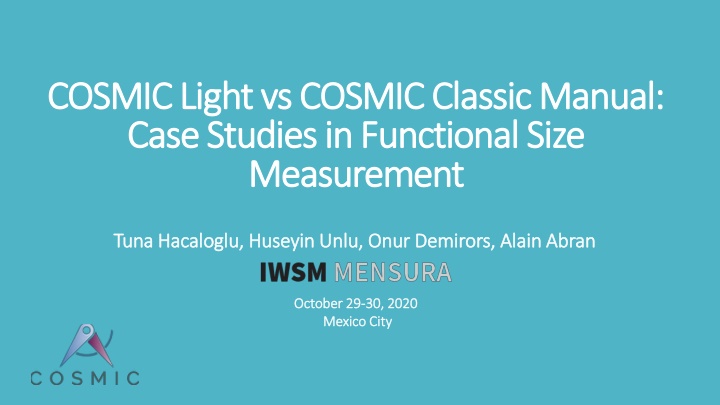

![❤[READ]❤ Cosmic Biology: How Life Could Evolve on Other Worlds (Springer Praxis](/thumb/21556/read-cosmic-biology-how-life-could-evolve-on-other-worlds-springer-praxis.jpg)
